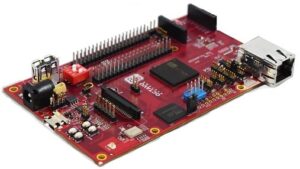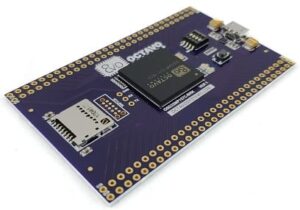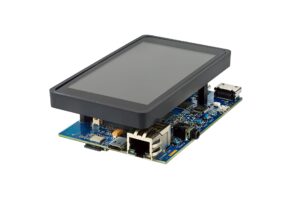To learn more about our power devices, we have a webinar covering our wide catalog.
It’s on the heels of the first STM32MP1 at 800 MHz that Octavo Systems, a System in Package maker and an ST Authorized Partner, announced the smallest 800 MHz STM32MP1 module, the OSD32MP15x. The SiP integrates an STM32MP15x microprocessor and more than a hundred passive components as well as up to 1 GB of DDR3L and the STPMIC1 responsible for the power management. Engineers can start testing the new device on the OSD32MP1-RED, a development platform that embarks a Wi-Fi / Bluetooth Module, an Ethernet port, a USB host, a microSD card slot, and that supports an HDMI or DSI display. The four-layer PCB design can also serve as a reference point to designers on their prototyping journey. Octavo offers the OSD32MP1-BRK breakout board if developers want complete flexibility in their prototype design.
As we recently saw on this blog, one of the 10 commandments of working with an MPU is to seriously consider using a System-in-Package or a System-on-Module instead of trying to come up with an MPU design from scratch. A SiP takes the dies of various devices and places them inside one package while a SoM takes multiple packages and puts them into one module. In both cases, they turn a microprocessor into something akin to a microcontroller, meaning that by integrating these components under one roof, they alleviate some the complexities that come from MPUs. Nonetheless, as designers that are new to MPUs may not fully grasp all the advantages of SiP, we sat down with Octavo to take a closer look at their OSD32MP15x to highlight what’s inside its package and help readers decide if this sort of component is right for them.
STPMIC1 and OSD32MP15X or When a Small SiP Means Fewer Components and Simpler Designs

The OSD32MP15x is fascinating because, among other things, it highlights the importance of the hardware ecosystem that exists around the STM32MP1 MPUs, such as the STPMIC1. The small power management IC has a wide input voltage range spanning from 2.8 V to 5.5 V, six LDOs, one Vref for DDR memories, a boost SMPS to power up to three USB ports, and four buck switch-mode power supplies, thus enabling various memory and MPU configurations as well as an automatic power detection system to turn the STPMIC1 when plugging a cable. As Greg Sheridan, VP of Strategy and Marketing Manager for Octavo Systems LLC explained:
“The STM32MP1 and STPMIC1 offer such levels of optimizations that we were able to create a complete module that’s only 18 mm x 18 mm. This is possible because the small size of the overall design and the architecture of the STPMIC1 enable us to put signal paths and power rails so close to each other that we were able to eliminate some bulk and bypass capacitors. It’s all about offering maximum performance in the smallest package possible, which wouldn’t be possible without the STPMIC1 and our SiP technologies.”
STPMIC1 and OSD32MP15X or When Integrated Solution Means More Flexibility and Reliability
The fact that STPMIC1 also integrates numerous voltage rails as well as monitoring, protection, and control features vastly improves the overall reliability. Instead of having a myriad of external components, which multiplies the possibility of failures, having this one monolithic implementation is a great agent of simplification and robustness.
Greg also explained that Octavo wouldn’t be able to build a similar power management IC on their own without making the OSD32MP15x costlier and significantly larger. Ultimately, the STPMIC1 offers a single input voltage rail, which makes the SiP very easy to power, while its 14 output rails can power the MPU, DDR memories, and the rest of the components within the package, plus some external devices as well. The STPMIC1 helped Octavo move to the new 800 MHz STM32MP1 by simply adjusting the voltage, instead of performing a complete redesign. Such an integrated system also means that Octavo’s customers have an experience that’s closer to a microcontroller than the average MPU user.
OSD32MP15X and STPMIC1: Faster Time to Market for Big Projects

Another exciting feature of the OSD32MP15x is that it is completely compatible with the ST software tools. For instance, engineers can start their project on our STM32MP157C-DK2 and have the assurance that everything will run on the OSD32MP15x, which is a testament to the close relation between ST and Octavo. Greg shared some of the origin story of his company’s SiP when he told us:
“Our teams started their design work on the STM32MP157C-DK2, learned from the schematics, analyzed ST’s implementations, then came up with a SiP that we tested by removing discrete components from the ST development board and inserting our prototype. Our engineers also used STM32CubeMX, STM32CubeProgrammer, and the OpenSTLinux Starter package to hasten developments and ensure that our solution would support the ST utilities to increase our SiP’s accessibility.”

The fact that the STM32MP157C-DK2 uses the STPMIC1 helped Octavo integrate the power management IC within their SiP. Engineers may also choose to use the ST device by itself with another MPU and try it out on the STEVAL-PMIC1K1. Regardless, we wanted to highlight Octavo’s solution because for a lot of teams, taking advantage of the OSD32MP15x means being able to spend more time on the software and its features, instead of dealing with complex power management schemes and routing DDR signal issues. It also signifies that even if a project doesn’t target tremendous mass-market volumes or if a design suffers from tight spatial constraints, it can still benefit from the computational throughput that enables powerful applications, such as image recognition or machine learning. Octavo explained that many of their customers actually gravitate toward the more powerful STM32MP15s in search of the next big thing.
